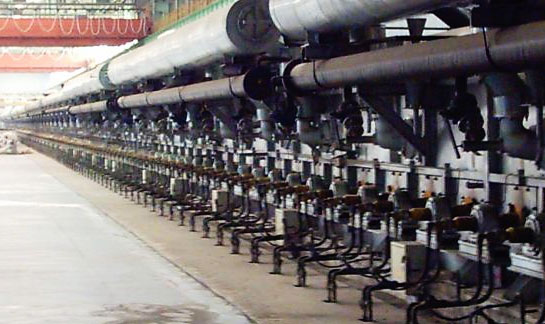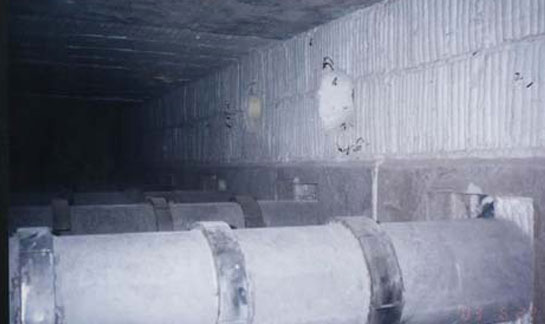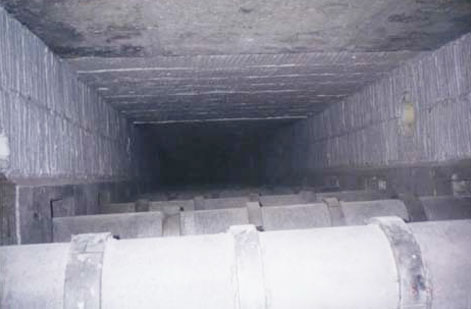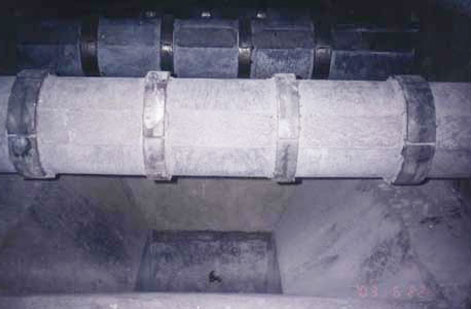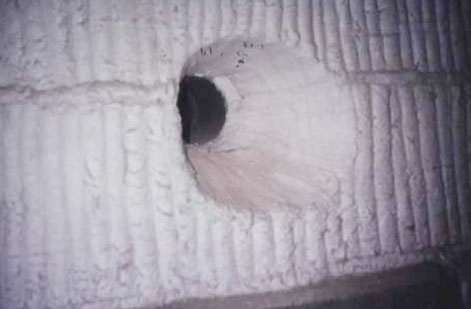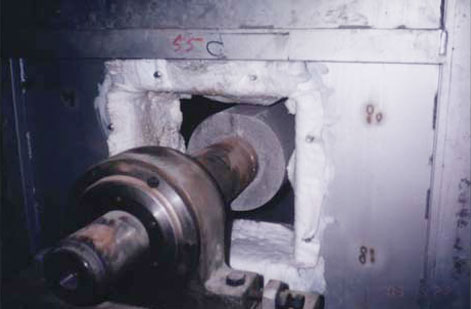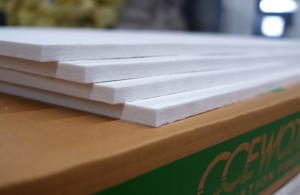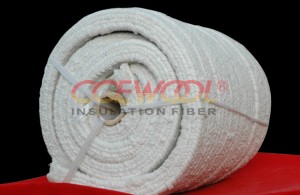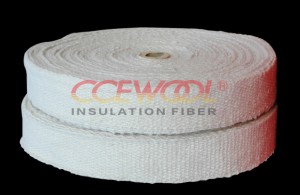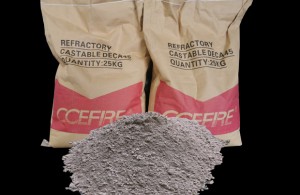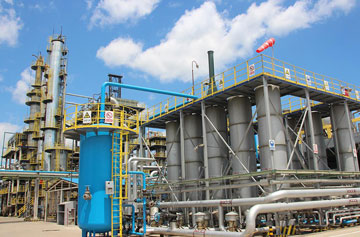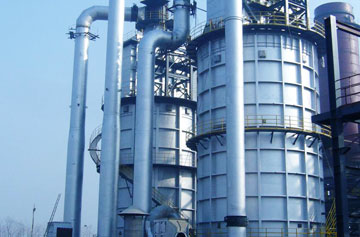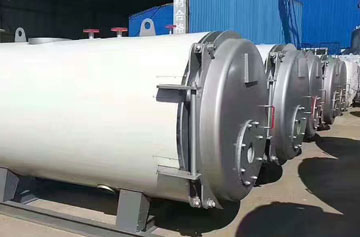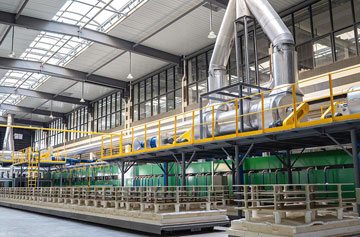Design and construction of roller hearth soaking furnaces for continuous casting and rolling
Furnace overview:
The thin slab casting and rolling process is a relatively compact and efficient new furnace technology, which is to cast 40-70 mm thin slabs with the continuous casting machine and after heat preservation or local heating, they are sent to the hot strip rolling mill to be directly rolled into 1.0-2.3 mm thick strips.
The normal furnace temperature of the CSP production line is 1220 ℃; the burners are high-speed burners, which are installed in interlacement on both sides. The fuel is mostly gas and natural gas, and the operating environment in the furnace is weakly oxidizing.
Because of the above operating environments, the main materials of the furnace lining which uses the current GSP line furnace technology are all designed with refractory ceramic fiber materials.
The application structure of ceramic fiber lining materials
Furnace cover and walls:
The furnace lining structure that combines CCEWOOL1260 refractory ceramic fiber blankets and CCEWOOL 1430 containing zirconium ceramic fiber modules is adopted. The ceramic fiber modules are arranged in “a battalion of soldiers” type, and the module anchoring structure is a butterfly type.
Technical advantages:
1) The ceramic fiber modules are an organ-shaped assembly made by continuously folding and compressing the ceramic fiber blankets and embedding anchors. They have a large elasticity, so after the modules are installed and the binding parts of the module are removed, the compressed ceramic fiber blankets can rebound and squeeze each other tightly to ensure the seamlessness of the furnace lining.
2) The use of the layered-module composite structure can firstly reduce the overall costs of the furnace lining, and secondly ensure the service life of the anchors which are located between the layered ceramic fiber carpets and ceramic fiber modules. In addition, the fiber direction of the ceramic fiber blankets is vertical to the folding direction of the modules, which can effectively improve the sealing effects.
3) The ceramic fiber modules adopt a butterfly structure: This structure not only provides a firm anchoring structure, but also ensures that after the modules are installed and the protective sheet is removed, the compressed folding blankets can rebound fully, and the expansion is completely free from the anchoring structure, which guarantees the seamlessness of the furnace lining. Meanwhile, since there is only a seam of a layer of steel plate between the ceramic fiber modules and the insulation layer, this structure can achieve a tight contact between the insulation layer and ensure the uniform thickness of the furnace ling in a smooth and beautiful finish.
The connecting beam
The CCEWOOL light heat-insulating castable prefabricated block structure makes the prefabricated blocks into an inverted “T” structure through the “Y” anchor nails. During construction, the prefabricated blocks with pre-embedded bolts will be fixed on the steel frame of the furnace top with screw nuts.
Technical advantages:
1. The inverted T-shaped castable prefabricated block structure allows the two end linings of the furnace cover to be buckled into the castable wall lining structure, so that the connecting parts form a labyrinth structure, which can achieve a good sealing effect.
2. Easy construction: This part is pre-formed with castable. During construction, only the standing screw of the prefabricated block needs to be fixed onto the steel frame structure of the furnace top with screw nuts and gaskets. The whole installation is very simple, greatly reducing the on-site pouring difficulty in construction.
The slag bucket:
The upper vertical section: adopts the composite structure of CCEWOOL high-strength castable, heat-insulating castable, and 1260 ceramic fiberboards.
The lower inclined section: adopts the composite structure of CCEWOOL high-strength castable and 1260 ceramic fiberboards.
The fixing method: Weld a 310SS screw on the standing screw. After laying the fiberboards, screw a “V” type anchor nail with a screw nut on the standing screw and fix the castable.
Technical advantages:
1. This is the main section to largely remove oxide scale. The composite structure of CCEWOOL castable and ceramic fiberboards can meet the requirements of this section for the operational strength.
2. The use of both refractory castable and thermal insulation castable ensures the effects of furnace lining and reduces project costs.
3. The use of CCEWOOL ceramic fiberboards can effectively reduce the heat loss and the weight of the furnace lining.
The structure of furnace roll sealing:
The CCEWOOL ceramic fiber module structure divides the roller sealing block into two modules with a semi-circular hole on each and buckles them on the furnace roller respectively.
This sealing structure not only ensures the excellent sealing performance of the furnace roller part, but also reduces heat loss and extends the service life of the furnace roller. In addition, each hearth roller sealing block is independent from each other, which makes the replacement of the hearth roller or the sealing material more convenient.
The billet's entrance and exit gates:
The use of CCEWOOL ceramic fiber module structure can make the lifting of the furnace door much easier, and because of the low heat storage of the ceramic fiber materials, the heating speed of the furnace greatly increases.
In consideration of large-scale continuous- operation furnaces (roller hearth furnaces, walking-type furnaces, etc.) in metallurgy, CCEWOOL introduced a simple and efficient door-structure -- fire curtain, which has a composite structure of a fiber blanket sandwiched between two layers of fiber cloth. Different hot surface materials can be selected according to the different temperatures of the heating furnace. This application structure has several advantages, such as trouble-free furnace door mechanism, easy installation and use, no assembly and disassembly required, and free pass of lifting and steel plates. It can also effectively block radiation heat transfer, resist corrosion, and maintain stable physical and chemical properties at high temperatures. Therefore, it should be used on the inlet and outlet doors of continuously operating furnaces, and because it is simple, economical, and practical, it is a new application structure with a very high market value.
Post time: Apr-30-2021


